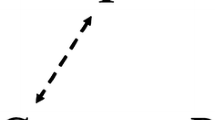Abstract
In what follows, I argue that the semantic approach to scientific theories fails as a means to present the Wright–Fisher formalism (WFF) of population genetics. I offer an account of what population geneticist understand insofar as they understand the WFF, a variation on Lloyd’s view that population genetics can be understood as a family of models of mid-level generality.
Similar content being viewed by others
References
Beatty J. (1980) Optimal-design models and the strategy of model building in evolutionary biology. Philosophy of Science 47: 532–561
Beatty J. (1982) What’s wrong with the received view of evolutionary theory?. In: Asquith P. D., Giere R. N. (eds) PSA proceedings of the 1980 biennial meetings of the Philosophy of Science Association. Philosophy of Science Association, East Lansing, MI, pp 397–426
Beatty J. (1987) On behalf of the semantic view. Biology and Philosophy 2: 17–23
Ereshefsky M. (1991) The semantic approach to evolutionary theory. Biology and Philosophy 6: 59–80
Ewens W. J. (2004) Mathematical population genetics: 1. Theoretical introduction. Springer, New York
Franklin I., Lewontin R. C. (1970) Is the gene the unit of selection?. Genetics 65: 707–734
Gigord, L. D. B., Macnair, M. R., & Smithson, A. (2001). Negative frequency-dependent selection maintains a dramatic flower color polymorphism in the rewardless orchid Dactylorhiza sambucina. Proceedings of the National Academy of Sciences of USA, 98, 6253–6255.
Hedrick P. W. (2005) Genetics of populations. Jones and Bartlett, Boston
Kerr B., Godfrey-Smith P. (2002) Individualist and multi-level perspectives on selection in structured populations. Biology and Philosophy 17: 477–517
Kingman J. F. C. (1961) A matrix inequality. Quarterly Journal of Mathematics 12: 78–80
Laland, K. N., Odling-Smee, F. J., & Feldman, M. W. (1999). Evolutionary consequences of niche construction and their implications for ecology. Proceedings of the National Academy of Sciences of the United States of America, 96(18), 10242–10247.
Lloyd E. (1983) A semantic approach to the structure of population genetics. Philosophy of Science 51: 242–264
Lloyd E. (1994) The structure and confirmation of evolutionary theory. Princeton University Press, Princeton, NJ
Lloyd E., Lewontin R. C., Feldman M. W. (2008) The generational cycle of state spaces and adequate genetical representation. Philosophy of Science 75: 140–156
Maynard Smith J. (1974) The theory of games and the evolution of animal conflicts. Journal of Theoretical Biology 47: 209–221
Millstein, R., & Skipper, R. A. (2007). Population genetics. In D. Hull & M. Ruse (Eds.), The Cambridge companion to philosophy of biology (pp. 22–43). Cambridge: Cambridge University Press.
Rice S. (2004) Evolutionary theory: Mathematical and conceptual foundations. Sinauer and Associates, Sunderland, MA
Rinkevich B., Porat R., Goren M. (1995) Allorecognition elements on a urochordate histocompatibility locus indicate unprecedented extensive polymorphism. Proceedings: Biological Sciences 259: 219–324
Thompson P. (1983) The structure of evolutionary theory: A semantic approach. Studies in History and Philosophy of Science 14: 215–229
Thompson P. (1987) A defense of the semantic conception of evolutionary theory. Biology and Philosophy 2: 26–32
Thompson P. (1988) Conceptual and logical aspects of the ‘New’ evolutionary epistemology. In: Matthen M., Linsky B. (eds) Philosophy and biology. University of Calgary Press, Calgary, AB
Thompson P. (1989) The structure of biological theories. State University of New York Press, Albany, NY
Thompson P. (2007) Formalisations of evolutionary biology. In: Matthen M., Stephens C. (eds) Handbook of the philosophy of science, Volume 2: Philosophy of biology. Elsevier, Amsterdam, pp 485–524
van Fraassen B. (2006) Representation: The problem for structuralism. Philosophy of Science 73: 536–547
Author information
Authors and Affiliations
Corresponding author
Rights and permissions
About this article
Cite this article
Gildenhuys, P. Classical population genetics and the semantic approach to scientific theories. Synthese 190, 273–291 (2013). https://doi.org/10.1007/s11229-012-0146-3
Received:
Accepted:
Published:
Issue Date:
DOI: https://doi.org/10.1007/s11229-012-0146-3




